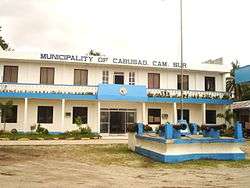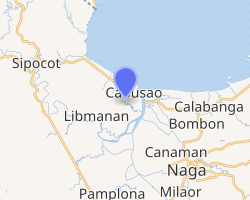Cabusao, Camarines Sur
Cabusao, officially the Municipality of Cabusao (Central Bicolano: Banwaan kan Cabusao; Tagalog: Bayan ng Cabusao), is a 5th class municipality in the province of Camarines Sur, Philippines. According to the 2015 census, it has a population of 18,397 people.[4]
Cabusao | |
|---|---|
| Municipality of Cabusao | |
 Municipal Hall | |
 Seal | |
 Map of Camarines Sur with Cabusao highlighted | |
OpenStreetMap 
| |
.svg.png) Cabusao Location within the Philippines | |
| Coordinates: 13°43′N 123°06′E | |
| Country | |
| Region | Bicol Region (Region V) |
| Province | Camarines Sur |
| District | 1st district |
| Barangays | 9 (see Barangays) |
| Government | |
| • Type | Sangguniang Bayan |
| • Mayor | Weny A. Sabalbero [2] |
| • Vice Mayor | Jopito O. Agualada |
| • Congressman | Marissa Lourdes M. Andaya |
| • Electorate | 13,362 voters (2019) |
| Area | |
| • Total | 46.80 km2 (18.07 sq mi) |
| Population (2015 census)[4] | |
| • Total | 18,397 |
| • Density | 390/km2 (1,000/sq mi) |
| • Households | 3,897 |
| Demonym(s) | Cabusaoeños |
| Economy | |
| • Income class | 5th municipal income class |
| • Poverty incidence | 42.01% (2015)[5] |
| • Revenue (₱) | 56,735,762.40 (2016) |
| Time zone | UTC+8 (PST) |
| ZIP code | 4406 |
| PSGC | |
| IDD : area code | +63 (0)54 |
| Climate type | tropical rainforest climate |
| Native languages | Central Bikol Tagalog |
| Website | www |
History
Fishing still remains as the major industry in the Cabusao town in the first district of the province. There are attempts, however, to improve the rice production which can only be done if the farmlands can be improved despite the salty soil.
In Barangay San Pedro in this municipality, the Bicol sanitarium can be found where leprous patients are treated and taken care of.
Barangays
Cabusao is politically subdivided into 9 barangays.
- Barceloneta
- Biong
- Camagong
- Castillo
- New Poblacion
- Pandan
- San Pedro
- Santa Cruz
- Santa Lutgarda
Santa Lutgarda was formerly the Barrio Poblacion; the seat of the municipal government and the town's Catholic church. Through the effort of Mayor Teofilo Santiago, those two major symbol of local power was transferred to the neighboring Barrio Buenavista, presently Barangay New Poblacion. However, the name "Poblacion" is still an integral part of Santa Lutgarda and can be found side by side with the official name (Santa Lutgarda de Bravante).
Demographics
|
| ||||||||||||||||||||||||||||||||||||||||||
| Source: Philippine Statistics Authority[4][6][7][8] | |||||||||||||||||||||||||||||||||||||||||||
In the 2015 census, the population of Cabusao was 18,397 people,[4] with a density of 390 inhabitants per square kilometre or 1,000 inhabitants per square mile.
Religion
The municipality is composed of two Catholic parishes, the San Bernardino de Siena Parish and the San Pascual Baylon Parish. Every barangay hold its own barangay fiesta to honor their village patron saint. During that event, the village is lavishly decorated, especially the route of the processions.
The Roman Catholic Church and the local authorities work side by side for a glorious and memorable fiestas. Although there is a separation of church and state, as stated in the country's constitution, the Catholic Church as an institution occupies a very high position in the society. The present pastoral program is geared toward organizing and strengthening the SKK (saradit na kristiyanong komunidad) which means BEC, basic ecclesial community. Rev. Fr. Apolinar "Yonyon" Rull Napoles Jr.organized the housing projects for the victims of typhoon "Reming" ( International name Durian). There are two new villages in the place called Dusayan Village (Caritas International) and the San Rafael GK (Gawad Kalinga) Village, both located in the north-east of barangay Castillo.
Among the non-Catholic religions are the Iglesia ni Cristo, Ang Dating Daan, Jesus Miracle Crusade and very small number of mainline Protestants.
The parish of St. Bernardine of Siena was founded in 1914. The Feastday is every 20th day of May.
The following is the list of parish priests:
- Fr. Santiago Bufete 1914-1915
- Fr. Fermin Borja 1915-1917
- Fr. Juan Villareal 1917-1940
- Fr. Brigido Villar 1941-1944
- Fr. Mariano Surtida1944
- Fr. Catalino Reyes 1944-1946
- Fr. Jorge Prepotente 1946-1947
- Fr. Vicente Ramos Ojeda 1947
- Fr. Basilio Quimpo 1947-1949
- Fr. Thomas Bernales 1949-1955
- Fr. Vicente Ramin 1955-1959
- Fr. Roque Maravillas 1959-1969
- Fr. Bonifacio De Vera 1969-1974
- Fr. Manuel Ricafort 1974-1979
- Fr. Edgar S. Pan 1979-1982
- Fr. John E. Tria 1982-1985
- Fr. Oscar P. Paraiso 1985-1991
- Fr. Luis Chito S. Valenciano 1991-1992
- Fr. Solh B. Saez 1992-1996
- Fr. Antonio A. Aureus 1996-1999
- Fr. Michael Alnor R. Dela Rosa 1999-2005
- Fr. Apolinar Rull Napoles Jr. 2005 January – 2008 October
- Fr. Arvin G. Olivan 2008 October–June 2014
- Fr. Cristito M. Testa June 2014-Present
Climate
Cabusao has varying dry and wet seasons. The dry season begins late March through May and the wet season starts early June through October. The climate and soil are suited for almost all kinds of agricultural crops. Northwest monsoon winds prevail during the months of late October to March. Southwest monsoon starts from June and ends in October.
| Climate data for Cabusao, Camarines Sur | |||||||||||||
|---|---|---|---|---|---|---|---|---|---|---|---|---|---|
| Month | Jan | Feb | Mar | Apr | May | Jun | Jul | Aug | Sep | Oct | Nov | Dec | Year |
| Average high °C (°F) | 33 (91) |
31 (88) |
35 (95) |
37 (99) |
38 (100) |
37 (99) |
36 (97) |
34 (93) |
35 (95) |
34 (93) |
33 (91) |
32 (90) |
35 (94) |
| Average low °C (°F) | 27 (81) |
27 (81) |
29 (84) |
31 (88) |
32 (90) |
32 (90) |
30 (86) |
29 (84) |
30 (86) |
29 (84) |
28 (82) |
28 (82) |
29 (85) |
| Average precipitation mm (inches) | 44.2 (1.74) |
52.17 (2.05) |
45.43 (1.79) |
92.29 (3.63) |
182.23 (7.17) |
289.11 (11.38) |
260.6 (10.26) |
180.07 (7.09) |
340.22 (13.39) |
98.7 (3.89) |
337.4 (13.28) |
81 (3.2) |
2,003.42 (78.87) |
| Average rainy days | 21 | 22 | 19 | 24 | 26 | 30 | 29 | 27 | 29 | 24 | 29 | 28 | 308 |
| Source: World Weather Online[9] | |||||||||||||
Economy
Cabusao is basically an agricultural town where most of its constituents are engaged in farming and fishing.
In 1997, agricultural workers reached to about 37.53% while 62.47% were non-agricultural workers.
- Crop Production
- Rice is the major agricultural crop grown in the municipality. Other crops planted in the municipality are coconut, root crops, vegetables and fruit bearing tree. The production pattern is generally two croppings a year in the area served by irrigation
- Livestock Production
- There are various livestock raisers in the municipality located in all barangays. Commercial raisers or cattle have their pastures and grazing grounds maintained. Poultry production is a very profitable business. There are numerous commercial raisers engaged in egg production.
- Fisheries and Aquatic Resources
- The municipality has vast fishing grounds situated at the San Miguel Bay. Bangus fry is abundantly catch during summer and thus constitutes to the revenues of the municipality. Presently, there are a large number of motorized and non-motorized fishing bancas used commonly by the fishermen on their fishing activities. The fishing method/gear used commonly by the fishermen includes hook and line, beach seines, gill nets, scissors nets, multiple hands lines and cabiao.
Education
The municipality has 2 Secondary Public Schools and 8 Public Elementary Schools. Sta Lutgarda High School is located at Barangay New Poblacion and the Barcelonita Fisheries School at Barangay Barcelonita.
References
- "Municipality". Quezon City, Philippines: Department of the Interior and Local Government. Retrieved 31 May 2013.
- "Archived copy". Archived from the original on 2017-01-08. Retrieved 2017-01-07.CS1 maint: archived copy as title (link)
- "Province: Camarines Sur". PSGC Interactive. Quezon City, Philippines: Philippine Statistics Authority. Retrieved 12 November 2016.
- Census of Population (2015). "Region V (Bicol Region)". Total Population by Province, City, Municipality and Barangay. PSA. Retrieved 20 June 2016.
- "PSA releases the 2015 Municipal and City Level Poverty Estimates". Quezon City, Philippines. Retrieved 1 January 2020.
- Census of Population and Housing (2010). "Region V (Bicol Region)". Total Population by Province, City, Municipality and Barangay. NSO. Retrieved 29 June 2016.
- Censuses of Population (1903–2007). "Region V (Bicol Region)". Table 1. Population Enumerated in Various Censuses by Province/Highly Urbanized City: 1903 to 2007. NSO.
- "Province of Camarines Sur". Municipality Population Data. Local Water Utilities Administration Research Division. Retrieved 17 December 2016.
- "Cabusao, Camarines Sur: Average Temperatures and Rainfall". World Weather Online. Retrieved 29 October 2017.
External links
| Wikimedia Commons has media related to Cabusao, Camarines Sur. |